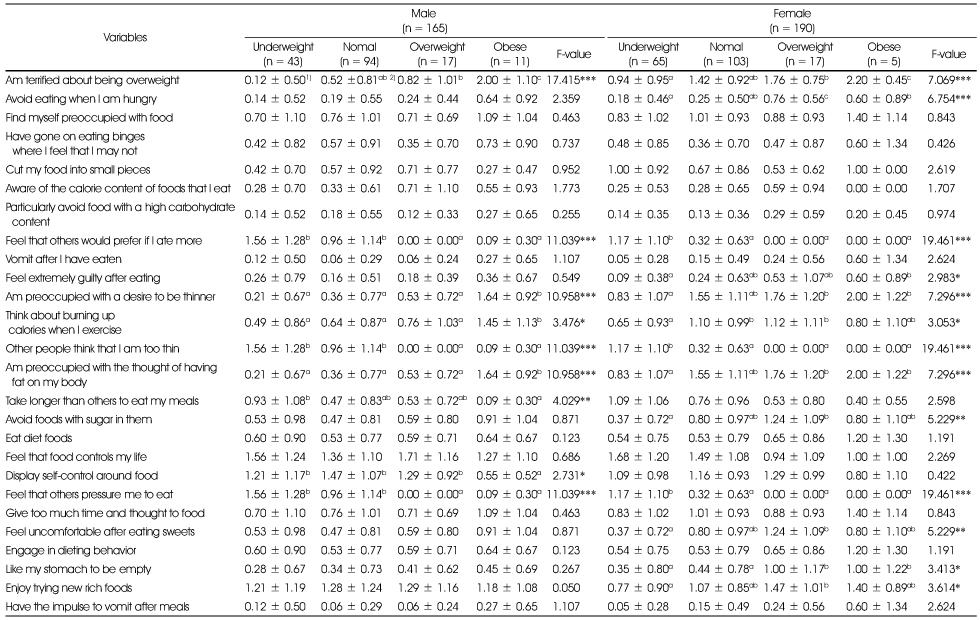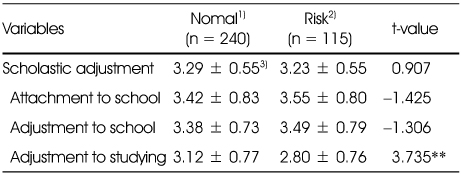Articles
- Page Path
- HOME > Korean J Community Nutr > Volume 17(6); 2012 > Article
-
Original Article
- A Study on the Correlation between Middle School Students' Eating Disorder Behavior and Scholastic Adjustment
- Joo-Yeon Yoo, Yang-Ho Jin, Se-Jeong Bae
-
Korean Journal of Community Nutrition 2012;17(6):707-713.
DOI: https://doi.org/10.5720/kjcn.2012.17.6.707
Published online: December 31, 2012
Department of Foodservice & Culinary Management, Graduate School of Kyonggi University, Seoul, Korea.
- Corresponding author: Se-Jeong Bae, Deptartment of Foodservice & Culinary Management, Graduate School of Kyonggi University, 71, Chungjeong-Ro 2-Ga, Seodemun-Gu, Seoul 120-702, Korea. Tel: (02) 390-5242, Fax: (02) 313-4131, baesejeong@hanmail.net
Copyright © 2012 The Korean Society of Community Nutrition
- 1,303 Views
- 2 Download
- 4 Crossref
Abstract
- The purpose of this study was to verify the difference of middle school students' eating disorder behavior and scholastic adjustment according to the gender and weight group and evaluate correlations between their eating disorder behavior and scholastic adjustment. A survey was conducted in middle school second graders attending five schools located in Seoul. Results from 355 questionnaire sheets were utilized for statistical analysis, and the results were gained as below: With regard to eating disorder behavior by gender, female students showed more eating disorder behavior than male students (p < 0.01); however, scholastic adjustment did not indicate significant differences by gender. According to the result of analyzing scholastic adjustment according to the weight group, the obese group showed lower scholastic adjustment (p < 0.05) and adjustment to studying (p < 0.01) than other groups; however, the eating disorder behavior, attachment to school, and adjustment to school did not indicate significant differences. According to the results of analyzing scholastic adjustment by eating disorder group, the normal group showed higher adjustment to studying than the risky group (p < 0.01). And scholastic adjustment, attachment to school, and adjustment to school did not indicate significant differences. The eating disorder behavior showed negative relationship with adjustment to studying. They showed more eating disorder behavior, their adjustment to studying became lower. Therefore, it is necessary to provide nutritional education at home and at school for them to have appropriate dietary habits as well as health education for them to maintain normal weight.
- 1. Bae JH, Choi JY. A study on psychological characteristics of eating disorders: A comparision with restrained, unrestrained (normal) eaters, and overweighters. Korean J Clin Psychol. 1997; 16(2): 209-217.
- 2. Cho MB. A study on the effects of eating behaviors and personality characteristics on Academic adaptation for higher grade elementary school students in certain regions of Busan. 2008; Kosin University; 42-43 MS thesis.
- 3. Choe JS, Chun HK, Chung GJ, Nam HJ. Relations between the dietary habit and academic achievement, subjective health judgement, physical status of high school students. J Korean Soc Food Sci Nutr. 2003; 32(4): 627-635.Article
- 4. Choi JH, Ahn DH, Nam JH, Cho YG, Choi BY. Reliability testing of eating attitude test for Korean adolescents. J Child Adolesc Psychiatry. 1998; 9(1): 91-97.
- 5. Choi MK, Kim MH, Lee YS, Cho HK, Kim KH, Lee BB, Sung MK, Sung CJ. Relation between obesity indices and, nutritional knowledge, nutritional status and blood parameters in obese middle-school students. J Korean Soc Food Sci Nutr. 2005; 34(2): 181-189.Article
- 6. Garner DM, Olmsted MP, Bour Y, Garfinkel PE. The eating attitudes test : Psychometric features and clinical correlates. Psychol Med. 1982; 12: 871-878.ArticlePubMed
- 7. Ha JS, Lee HG. Effect of middle-school students' food behavior on health condition and degree of study accomplishment. J Korean Home Econ Assoc. 1995; 33(3): 225-242.
- 8. Hancox RJ, Milne BJ, Poulton R. Association between child and adolescent television viewing and adult health: a longitudinal birth cohort study. Lancet. 2004; 364(9430): 257-262.ArticlePubMed
- 9. Kang MH, Choue RW. Relationships of body image, body stress and eating attitude, and dietary quality in middle school girls based on their BMI. Korean J Nutr. 2010; 43(3): 285-293.
- 10. Kim HH, Ro HK. A study on middle school students of Gwangu · Chonnam in terms of dietary life, dietary relates self-efficacy according to body mass index. Korean J Community Nutr. 2009; 14(5): 483-494.
- 11. Kim JH. Study on the physique status and eating disorder behavior among high school students in Daejeon. J Korean Home Econ Educ Assoc. 2002; 16(3): 115-129.
- 12. Kim KH, Yang KM. The relationship between eating disorders and parent-adolescent communication in middle school students in rural areas. J Korean Acad Nurs. 2008; 38(1): 55-63.
- 13. Kim SA, Lee BH. Relationships between the nutrient intake status, dietary habits, academic stress and academic achievement in the elementary school children in Bucheon-si. Korean J Nutr. 2008; 41(8): 786-796.
- 14. Kim SH. Children's growth and school performance in relation to breakfast. J Korean Diet Assoc. 1999; 5(2): 215-224.
- 15. Kim SN. A causal analysis among variables related to juvenile delinquency. 1994; Chonnam National University; 30-128 Dissertation.
- 16. Kwak SR. The adolescents' school adjustments to academic performances: a longitudinal study. Korean J Sociol Educ. 2008; 18(1): 1-20.
- 17. Lee HY, Kim HW. Current status and explanatory variables of eating problem among female middle school students. Korean J Youth Stud. 2011; 18(5): 413-433.
- 18. Lee JE, Cho MH. Impact of family, shool and neighborhood factors on youth school adjustment. Stud Korean Youth. 2007; 18(3): 79-102.
- 19. Rierdan J, Koff E. Weight, weight-related aspects of body image, and depression in early adolescent girls. Adolescence. 1997; 32(127): 615-624.PubMed
- 20. Sung MH. Relationship between eating disorders physical symptoms, depression and health locus of control among elementary school girls in South Korea. J Korean Acad Nurs. 2004; 34(3): 576-585.
- 21. WHO Western Pacific Region. The Asia-Pacific perspective: redefining obesity and its treatment. 2000.
- 22. Yim KS. Effects of obesity, body image dissatisfaction and dietary habits on the risk of disturbed eating attitudes among high school students in Gyunggi province, Korea. Korean J Community Nutr. 2010; 15(5): 656-669.
REFERENCES
Figure & Data
REFERENCES
Citations

- The big five personality traits and eating habits among female students at Zayed University
Sharifa AlBlooshi, Kawther AlSabbah, Shatha Thani, Rafiq Hijazi, Ayesha S. Al Dhaheri, Falak Zeb, Leila Cheikh Ismail
Frontiers in Public Health.2025;[Epub] CrossRef - Factors related to adolescent obesity and changes: a cross-sectional study based on the Korea Youth Risk Behavior Survey
Bora Lee, Ho Kyung Ryu
Korean Journal of Community Nutrition.2023; 28(5): 363. CrossRef - Analysis of Factors Influencing the Obesity of Adolescents in South Korea
Myung-Hee Jung, Jee-Seon Yi, Hye-Sun Jung
Journal of the Korean Society of School Health.2016; 29(1): 11. CrossRef - Gender differences in factors influencing the school adjustment by BMI
Ji Yeong Seo
Journal of the Korean Data and Information Science Society.2015; 26(2): 429. CrossRef
Anthropometric measurements and eating disorder behavior of subjects
1) Mean ± SD, 2) Not Significant, 3) N (%), 4) Nomal of eating disorder behavior: EAT-26 score < 20
5) Risk of eating disorder behavior: EAT-26 score ≧ 20
scholastic adjustment by gender
1) Mean ± SD
Eating disorder behavior and scholastic adjustment by weight group
1) Mean ± SD
2) Values with different alphabets with in each row are significantly different at α = 0.05 by Duncan's multiple range test
*: p < 0.05, **: p < 0.01
Eating disorder behavior by weight group
1) Mean ± SD
2) Values with different alphabets with in each row are significantly different at α = 0.05 by Duncan's multiple range test
*: p < 0.05, **: p < 0.01, ***: p < 0.001
Scholastic adjustment by eating disorder behavior group
1) Nomal of eating disorder behavior: EAT-26 score < 20
2) Risk of eating disorder behavior: EAT-26 score ≧ 20
3) Mean ± SD
**: p < 0.01
Correlation analysis
*: p < 0.05, **: p < 0.01
1) Mean ± SD, 2) Not Significant, 3) N (%), 4) Nomal of eating disorder behavior: EAT-26 score < 20 5) Risk of eating disorder behavior: EAT-26 score ≧ 20
1) Mean ± SD
1) Mean ± SD 2) Values with different alphabets with in each row are significantly different at α = 0.05 by Duncan's multiple range test *: p < 0.05, **: p < 0.01
1) Mean ± SD 2) Values with different alphabets with in each row are significantly different at α = 0.05 by Duncan's multiple range test *: p < 0.05, **: p < 0.01, ***: p < 0.001
1) Nomal of eating disorder behavior: EAT-26 score < 20 2) Risk of eating disorder behavior: EAT-26 score ≧ 20 3) Mean ± SD **: p < 0.01
*: p < 0.05, **: p < 0.01

 KSCN
KSCN






 Cite
Cite


